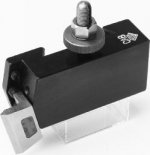hepburnman
Aluminum
- Joined
- Feb 20, 2013
- Location
- NJ
Hi- I have heard different recommendations for the angle to set the compond at, 29 degrees or 29 1/2 degrees, for threading of barrels and I would like to know which is best and also why (if possible). My first attempt at threading used 29 1/2 degrees, and the action fit real nice, but I am not sure if I might be affecting the strength of the threads some how by using 29 1/2 degrees (as measured with the compound rotated CCCW when initially being perpedicular to the work). I understand that others like to thread with the compound set at zero degrees (perpendicular to the work piece - or they advance the cross-slide only when deepening the threads) but I have settled on threading using the compound so please DO NOT comment here whether compound or cross-slide is best to use (this could be a separate post if you'd like).
Thanks much!
Thanks much!




